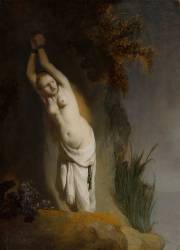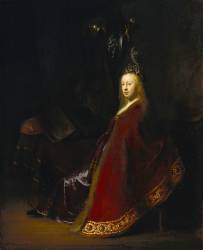Artwork of Rembrandt canvas prints & artprints
A key figure of the golden age of Dutch painting in the 17th century, Rembrandt is known for his striking self-portraits in oil, narrative paintings such as "The Anatomy Lesson of Doctor Tulp" and "Samson Betrayed by Delilah", and his dramatic use of light and shadow. Excelling in the art of portraiture and drawing, his compositions adorn the walls of many national galleries and museums, where canvases such as "La Ronde de nuit" still captivate today with their timeless style and expressiveness.
Discover the most emblematic canvases by this essential artist from the golden age of Dutch painting, with his portrait "Saskia van Uylenburgh, wife of the artist" (National Gallery of Art, Washington), a painting depicting his partner, his oil on canvas "Doctor tulp's anatomy lesson" (Mauritshuis, The Hague), his painting "The Blindness of Samson" (Städel Museum, Frankfurt am Main), a canvas in a historical style in vogue at the time, or his "Self-Portrait at the Age of 34" (National Gallery, London), an essential self-portrait by Rembrandt, part of an entire collection that he painted throughout his career.
Offer yourself a reproduction of Rembrandt, the man now considered one of the most important masters of 17th-century Dutch painting, and find out more about his biography.
Biography of Rembrandt
The youth and training of Rembrandt Van Rijn in Leiden
The child of a miller and a baker, Rembrandt van Rijn, better known simply as Rembrandt, was born in Leiden in 1606. From an early age, his talent for drawing asserted itself, with the artist quickly becoming interested in painting, in the stimulating environment that the Netherlands offered for the arts at the time. Very early on, Rembrandt set off to train with recognised masters, including the famous history painter Jacob van Swanenburgh, who taught him the basics of drawing and painting in the early 1620s, before continuing his apprenticeship with Joris van Schooten, where he learned pen-and-ink drawing, and then under the tutelage of another influential artist, Pieter Lastman, for whom the young artist moved to Amsterdam for a few months. Lastman imparted invaluable knowledge of composition and the depiction of historical and biblical scenes, but also introduced him to the paintings of Caravaggio, introducing him to chiaroscuro, notions that were to become undisputed characteristics of Rembrandt's technique.
Returning to Leiden in 1625, Rembrandt opened his own studio, in which he acquired a degree of freedom, took on his first commissions, and welcomed his first pupils. Rembrandt's artistic maturity developed during this period, and his work, concentrating on light and shadow, captured the essence of characters through portraits and canvases in which movement was the element that contributed to the painter's growing renown. Rembrandt also excelled at self-portraiture, painting his own face with an introspective honesty that was rare for the time.
During these formative years, Van Rijn's work stood out for the depth and vivacity of his paintings, as well as his mastery of portraiture. In Leiden, Rembrandt thus laid the foundations of a career, without making the inevitable initiatory journey to Italy, like many of his contemporaries.
Recognition and a flourishing career for Rembrandt in Amsterdam
In 1631, Rembrandt van Rijn moved to Amsterdam. Recognition of his mastery of oil painting on canvas and his ability to capture the essence of his subjects quickly won him a prestigious and demanding clientele. In 1634, one of the most significant events in his personal life occurred when he met Saskia van Uylenburgh, the woman who was to become his muse and wife. Often immortalised in Rembrandt's portraits and paintings, her captivating face became a recurring feature in his work. Niece of the art dealer Hendrick van Uylenburgh, Rembrandt was quickly introduced to Amsterdam high society. Thus, via the intermediary of Constantijn Huygens, he painted the figures in his famous "Dr Tulp's Anatomy Lesson" on behalf of Frederick-Henri of Orange-Nassau, child of William I of Orange-Nassau, considered the founder of Dutch civilisation.
As the sale of his canvases to the city's notables attested to his growing success, his Amsterdam studio was never empty, and his paintings, often narrative scenes or portraits, and his talent for depicting people charmed art lovers with their striking realism and the emotional richness they conveyed. Rembrandt joined the Saint Luke's guild at the same time, solidifying his status in Amsterdam's artistic community, this membership giving him a definite authority among his peers and reinforcing his position as a respected painter.
The financial ease generated by the sale of his works enabled him to acquire a sumptuous house in the heart of Amsterdam in 1639. He moved there and set up his studio, from which he created some of his most memorable paintings, including "The Night Watch", a painting that marks the apogee of his technique of group portraiture and lively scenes, where movement is portrayed to perfection. In 1641, the birth of his son Titus added to his family happiness, although the joy was short-lived, as Saskia's health deteriorated until her death in 1642. The death of his wife and muse left Rembrandt a widower, and the artist later expressed deep melancholy in his self-portraits. It was during this troubled period that Rembrandt met Geertje Dircx, who not only became his son's governess and lover, but also the new subject of his paintings. The depiction of female figures such as Geertje and previously Saskia would continue to play a central role in his work, through a series of portraits that let every emotion of his subject shine through.
Despite these personally troubled years, Rembrandt van Rijn experienced one of his most prolific and inspired periods, establishing his legacy as a master of chiaroscuro and painter of human feeling, through majestic paintings such as "Samson accusing his father-in-law". The Dutch painter demonstrates his ability to breathe life into the faces and figures he depicts, often immersed in a play of light of great virtuosity, his technique earning him exceptional renown on the Dutch and European art scene.
Rembrandt's legal troubles
In Amsterdam, although Rembrandt van Rijn's professional career was a success from the moment he set up home in 1631, his private life experienced many upheavals from the death of his partner in 1642. After living with Geertje Dircx for several years, Rembrandt met Hendrickje Stoffels, who became Titus's new governess in 1645. Hendrickje's presence coincided with the tumultuous departure of Geertje Dircx, Titus's former nanny and Rembrandt's lover, which led to numerous legal disputes. The latter sued him in 1649, demanding compensation after the break-up of their love affair, this legal battle probably contributing to the decline in Rembrandt's painting output at the time.
Under financial and emotional pressure, Rembrandt's financial situation, already complicated due to the lawsuits, was exacerbated by a lack of commissions and the need to maintain a certain standard of living in Amsterdam. Despite the difficulties, he continued to create his works, although his rate of production fell considerably at this time. In addition, Saskia's will, although drawn up before this period, had a notable impact on the family's fortunes, as Rembrandt's late wife bequeathed Titus's share of the inheritance in trust, thus protecting her son's interests against her husband's potential imprudence.
This precaution taken by Saskia was nevertheless insufficient to safeguard Rembrandt's economic stability. In 1656, the situation reached a breaking point: Rembrandt was declared insolvent. This year marked a turning point, forcing the sale of his house, which had served as a holiday resort for the city's notables, as well as his studio and his valuable collection of paintings by artists renowned throughout Europe. The sale of his possessions, including his house and his collection of paintings, was an attempt to regularise his finances, but also meant the unravelling of part of his vital environment as a passionate artist and collector.
A poverty-stricken end to Rembrandt's career
Between 1658 and his death in 1669, Rembrandt continued to produce canvases that still resonate today for their profound humanity and technical mastery.
Hoping to redress his precarious financial situation, he set up an art trading partnership with Titus and Hendrickje in order to continue selling his works, as the artist was considered insolvent and unable to sell his paintings himself. The death of Hendrickje in 1663, who had in fact been his wife even though they had never officially married, followed by that of Titus in 1668, only served to increase his isolation. Never ceasing to paint, the compositions that followed these events bear witness to the turmoil in the artist's life, his canvases imbued with a sombre intensity and poignant introspection. During this tumultuous period, Rembrandt also produced several striking self-portraits that reveal his contemplation of the passage of time and the hardships endured.
Prived of his partner and son, Rembrandt eventually moved in with his daughter-in-law, Magdalena van Loo, who cared for him until her death. Rembrandt's financial situation having become disastrous, he lived from then on in modest conditions, a far cry from the pomp of his early years of success.
Much less productive than when he first arrived in Amsterdam, Rembrandt continued to work until the end, before succumbing in 1669, leaving behind an impressive artistic testament. His final works are considered some of the most emotive and expressive of his career, revealing a painter who, despite his trials, remains unsurpassed in his ability to capture the essence of human experience.
Despite an end in financial obscurity, today his works continue to feature prominently on the walls of the world's greatest museums, as a testament to a life dedicated to art.
Rembrandt: a unique painter leaving an exceptional legacy in art history
Rembrandt left an indelible mark on the world of painting. Having become one of the most revered painters of the Dutch Golden Age in the 17th century, his influence on the arts extends well beyond his death and continues to shape the way artists approach the light, style and movement that result from their paintings.
Undisputed master of oil painting on canvas, his exceptional ability to play with contrasts of light and shadow has been passed down from generation to generation. His history painting, rich in dramatic narrative and emotion, remains famous for its detail and originality, as evidenced by such outstanding examples as his canvases "The Blinding of Samson" or "Samson Betrayed by Delilah".
In portraiture, Rembrandt excelled in his ability to capture the human face and movements with brutal honesty and deep empathy, as in his "Young Girl with a Frame" or with his most famous group portrait "The Night Round". Whether in his depictions of wealthy merchants or in the intimacy of his own self-portraits, he revolutionised the technique by revealing the soul behind the face. Rembrandt's self-portraits offer a fascinating window into his personal and artistic development, making his paintings not only valuable for art history, but also for detecting the psychology of the artist himself.
Today, Rembrandt's paintings are exhibited in the world's greatest museums. An impressive collection can be found in major art and cultural venues, such as the National Gallery in London, the Louvre Museum, the Leiden Municipal Museum, and the Rijksmuseum in Amsterdam, among many others, allowing the public to come and admire the finesse of his brushwork up close. These museums take care to preserve and enhance the legacy of this phenomenal painter, ensuring that his work remains accessible and continues to inspire.
















































































































































